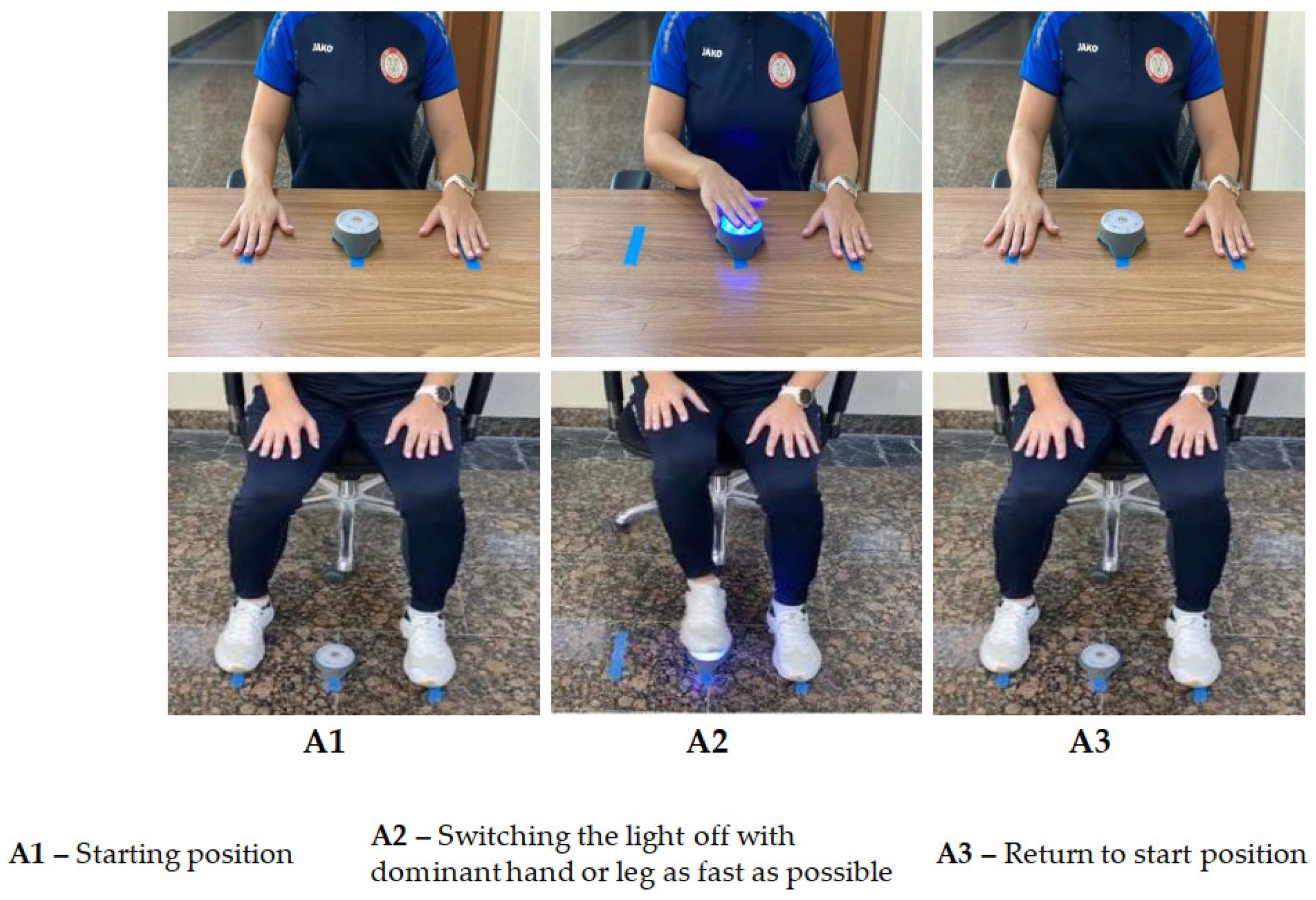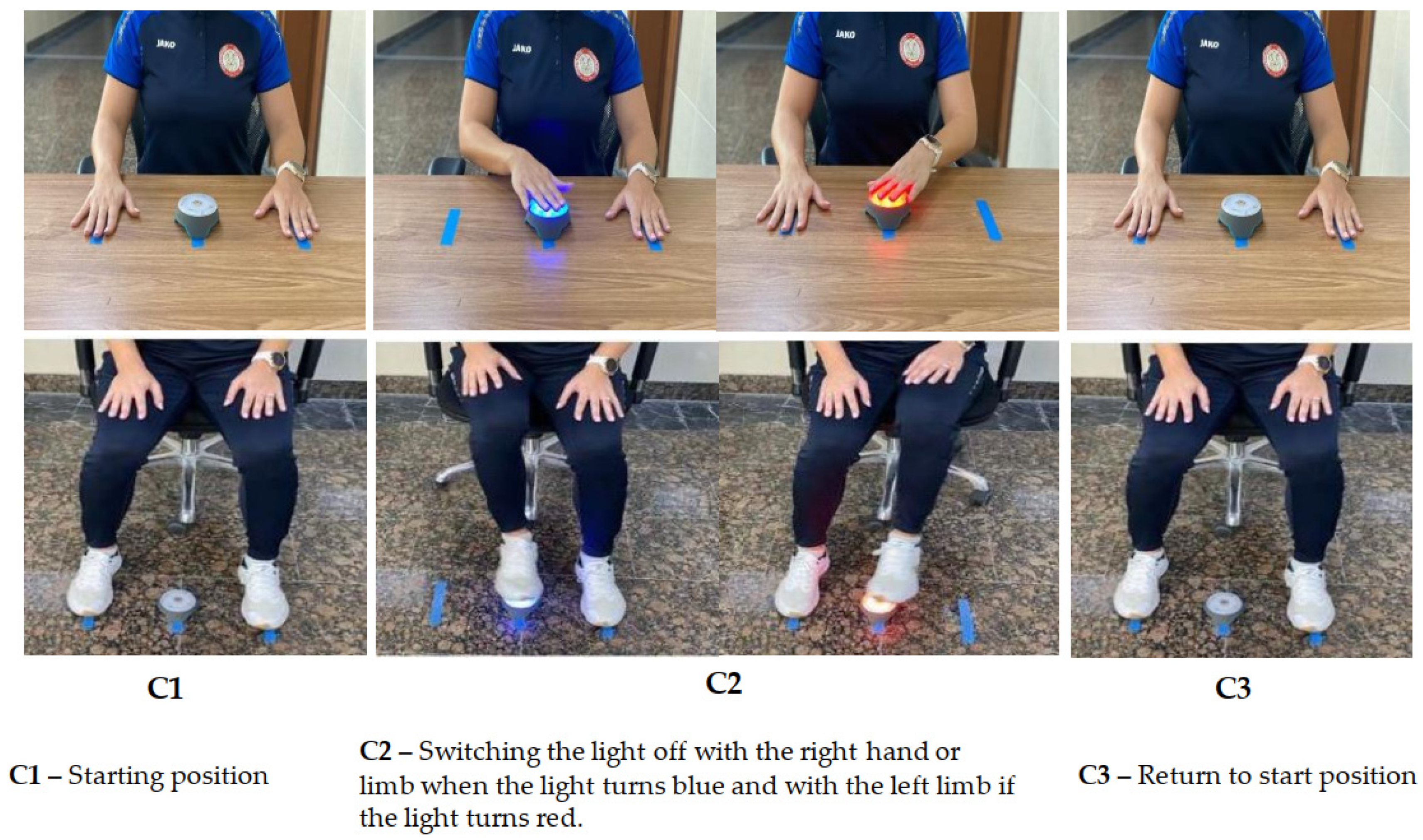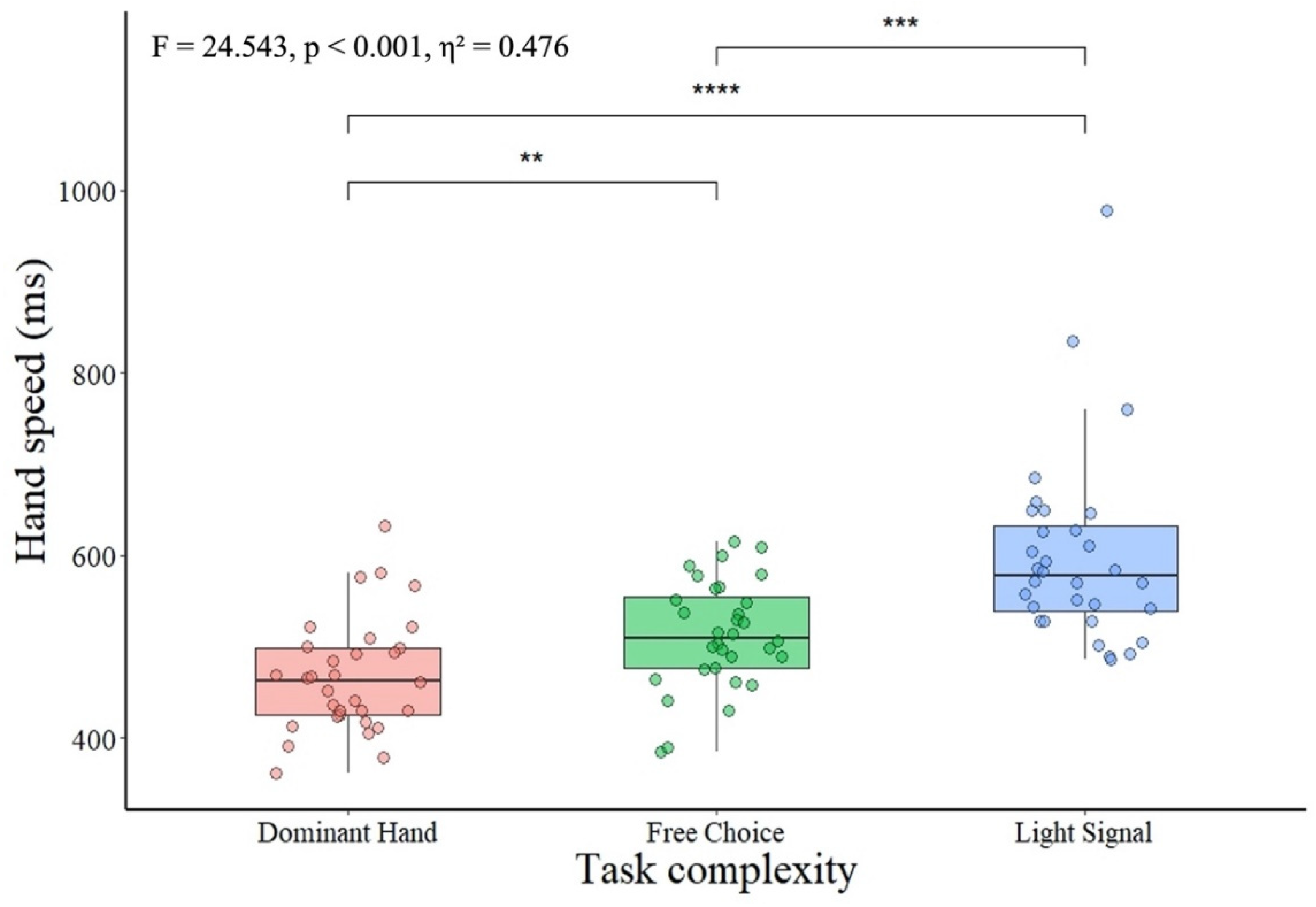Effects of the Task Complexity on the Single Movement Response Time of Upper and Lower Limbs in Police Officers
Abstract
:1. Introduction
2. Materials and Methods
2.1. Study Design
2.2. Participants
2.3. Hand and Leg Movement Speed
2.4. Variables
2.4.1. Hand Movement Response Times
- Dominant hand—hand movement response time on the light signal, expressed in ms;
- Free choice—hand movement response time on the light signal with free choice of either dominant or non-dominant hand, expressed in ms;
- Light signal—hand movement response time on the specific light signal. With right hand if the signal turns red and with left hand if signal turns blue, expressed in ms.
2.4.2. Leg Movement Response Time
- Dominant leg—leg movement response time on the light signal, expressed in ms;
- Free choice—leg movement response time on the light signal with free choice of either dominant or non-dominant hand, expressed in ms;
- Light signal—leg movement response time on the specific light signal. With right leg if the signal turns red and with left leg if the signal turns blue, expressed in ms.
2.5. Statistical Analysis
3. Results
4. Discussion
Limitations
5. Conclusions
Author Contributions
Funding
Institutional Review Board Statement
Informed Consent Statement
Data Availability Statement
Conflicts of Interest
Appendix A. Dominant Hand and Leg Movement Response Times

Appendix B. Free Choice of Hand and Leg Movement Response Times

Appendix C. Hand and Leg Movement Response Times on Specific Light Signal

References
- Dawes, J.; Roozen, M. Devoloping Agility and Quickness; National Strength and Conditioning Association (U.S), Human Kinetics: Colorado Springs, CO, USA, 2012; pp. 1–5.
- Korpanovski, N.; Berjan, B.; Bozic, P.; Pazin, N.; Sanader, A.; Jovanovic, S.; Jaric, S. Anthropometric and physical performance profiles of elite karate kumite and kata competitors. J. Hum. Kinet. 2011, 30, 107–114. [Google Scholar] [CrossRef] [PubMed]
- Blair, J.P.; Pollock, J.; Montague, D. Reasonableness and Reaction Time. Police Q. 2011, 14, 323–343. [Google Scholar] [CrossRef]
- Simonek, J.; Horicka, P.; Hianik, J. Differences in pre-planned agility and reactive agility performance in sport games. Acta Gymnica 2016, 46, 68–73. [Google Scholar] [CrossRef] [Green Version]
- Neilsen, G.H. Sport Psychology in Sport, Exercise and Physical Activity: The Development of Motor and Perceptual Skills in Young Athletes; IntechOpen: London, UK, 2021; 43p. [Google Scholar]
- Song, Y.; Ding, Y.; Fun, S.; Qu, Z.; Xu, L.; Peng, D. Neural substrates of visual perceptual learning of simple and complex stimuli. Clin. Neurophysiol. 2005, 116, 632–639. [Google Scholar] [CrossRef]
- Sanders, A.F. Elements of Human Performance: Reaction Processes and Attention in Human Skill; Lawrence Erlbaum Associates, Publishers: Mahwah, NJ, USA, 1998; p. 575. [Google Scholar]
- Sharkey, J.B.; Davis, O.P. Hard Work: Defining Physical Work Performance Requirements; Human Kinetics: Champaign, IL, USA, 2008; pp. 37–39. [Google Scholar]
- Starting, M.; Bakker, R.H.; Dijkstra, G.J.; Lemmink, K.A.P.M.; Groothoff, J.W. A job-related fitness test for the Dutch police. Occup. Med. 2010, 60, 255–260. [Google Scholar] [CrossRef] [Green Version]
- Wolpert, D.M.; Landy, M.S. Motor control is decision-making. Curr. Opin. Neurobiol. 2012, 22, 996–1003. [Google Scholar] [CrossRef] [Green Version]
- Gordon, J.; Maselli, A.; Lancia, G.L.; Thiery, T.; Cisek, P.; Pezzulo, G. The road towards understanding embodied decision. Neurosci. Biobehav. Rev. 2021, 131, 722–736. [Google Scholar] [CrossRef]
- Churchland, A.K.; Ditterich, J. New advances in understanding decisions among multiple alternatives. Curr. Opin. Neurobiol. 2012, 22, 920–926. [Google Scholar] [CrossRef] [Green Version]
- Marins, E.F.; Cabistany, L.; Farias, C.H.; Dawes, J.; Del Vecchio, F.B. Effects of personal protective on metabolism and performance during an occupational physical ability test for federal highway police officers. Strength Cond. Res. 2020, 34, 1093–1102. [Google Scholar] [CrossRef]
- Maupin, D.; Wills, T.; Orr, R.; Schram, B. Fitnes profiles in elite tactical units: A crictical review. Int. J. Exerc. Sci. 2018, 11, 1041–1062. [Google Scholar]
- Marins, E.F.; David, G.B.; Del Vecchio, F.B. Characterization of the physical fitness of police officers: A systematic review. Strength Cond. Res. 2019, 33, 2860–2874. [Google Scholar] [CrossRef] [PubMed]
- Muirhead, H.; Orr, R.; Schram, B.; Kornhauser, C.H.; Holmes, R.; Dawes, J. The relationship between fitness and marksmanship in police officers. Safety 2019, 5, 54. [Google Scholar] [CrossRef] [Green Version]
- Di Nota, P.M.; Hunta, J.M. Complex motor learning and police training: Applied, cognitive, and clinical perspectives. Front. Psychol. 2019, 10, 1797. [Google Scholar] [CrossRef]
- Lentine, T.; Johnson, Q.; Lockie, R.; Joyce, J.; Orr, R.; Dawes, J. Occupational challenges to the development and maintenance of physical fitness within law enforcement officers. JSCR 2021, 43, 115–118. [Google Scholar] [CrossRef]
- de-Oliveira, A.L.; Matos, V.M.; Fernandes, G.S.I.; Nascimento, A.D. Test-Retest Reliability of a Visual-Cognitive Technology (BlazePod™) to Measure Response Time. J. Sports Sci. Med. 2021, 20, 179–180. [Google Scholar] [CrossRef] [PubMed]
- Hoffman, J.R. Evaluation of a Reactive Agility Assessment Device in Youth Football Players. J. Strength Cond. Res. 2020, 34, 3311–3315. [Google Scholar] [CrossRef] [PubMed]
- Sullivan, G.M.; Feinn, R. Using Effect Size-or Why the P Value Is Not Enough. J. Grad. Med. Educ. 2012, 4, 279–282. [Google Scholar] [CrossRef] [Green Version]
- Hick, W.E. On the rate of gain of information. Q. J. Exp. Psychol. 1952, 4, 11–26. [Google Scholar] [CrossRef]
- Schmidt, R.A.; Lee, T. Motor Control and Learning; Human Kinetics: Champaign, IL, USA, 2011; p. 87. [Google Scholar]
- Mudric, M.; Cuk, I.; Nedeljkovic, A.; Jovanovic, S.; Jaric, S. Evaluation of Video-based method for the measurement of reaction time in specific sport situation. Int. J. Perform. Anal. Sport 2015, 15, 1077–1089. [Google Scholar] [CrossRef]
- Agnew, A.J.; Zeffiro, A.T.; Eden, F.G. Left hemisphere specialization for the control of voluntary movement rate. Neuroimage 2004, 22, 289–303. [Google Scholar] [CrossRef]
- Boulinguez, P.; Barthelemy, S.; Debu, B. Influence of the movement parameter to be controlled on manual RT asymmetries in right-handers. Brain Cogn. 2000, 44, 653–661. [Google Scholar] [CrossRef] [PubMed]
- Haaland, K.Y.; Elsinger, L.C.; Mayer, R.A.; Durgerian, S.; Rao, M.S. Motor sequence complexity and performing hand produce differential patterns of hemispheric lateralization. J. Cogn. Neurosci. 2004, 16, 621–636. [Google Scholar] [CrossRef] [PubMed]
- Meister, I.; Krings, T.; Foltys, H.; Boroojerdi, B.; Muller, M.; Topper, R.; Thron, A. Effects of long-term practice and task complexity in musicians and nonmusicians performing simple and complex motor tasks: Implications for cortical motor organization. Hum. Brain Mapp. 2005, 25, 345–352. [Google Scholar] [CrossRef] [PubMed]
- Shen, Y.C.; Franz, E.A. Hemispheric competition in left-handers on bimanual reaction time tasks. J. Mot. Behav. 2005, 37, 3–9. [Google Scholar] [CrossRef]
- Lenhard, A.; Hoffmann, J. Constant error in aiming movements without visual feedback is higher in the preferred hand. Laterality 2007, 12, 227–238. [Google Scholar] [CrossRef]
- Mieschke, P.E.; Elliott, D.; Helsen, W.F.; Carson, R.G.; Coull, J.A. Manual asymmetries in the preparation and control of goal-directed movements. Brain Cogn. 2001, 45, 129–140. [Google Scholar] [CrossRef] [Green Version]
- Velay, J.L.; Benoit-Dubrocard, S. Hemispheric asymmetry and interhemispheric transfer in reaching programming. Neuropsychologia 1999, 37, 895–903. [Google Scholar] [CrossRef]
- Bestelmeyer, P.E.; Carey, D.P. Processing biases towards the preferred hand: Valid and invalid cueing of left-versus right-hand movements. Neuropsychologia 2004, 42, 1162–1167. [Google Scholar] [CrossRef]
- Helsen, W.F.; Starkes, J.L.; Elliot, D.; Buekers, M.J. Manual asymmetries and saccadic eye movements in righthanders during single and reciprocal aiming movements. Cortex 1998, 34, 513–529. [Google Scholar] [CrossRef]
- Neely, K.; Binsted, G.; Heath, M. Manual asymmetries in bimanual reaching: The influence of spatial compatibility and visuospatial attention. Brain Cogn. 2005, 57, 102–105. [Google Scholar] [CrossRef]
- Gazzaniga, M.S. The ethical brain. J. R. Soc. Med. 2005, 98, 433–434. [Google Scholar]
- Adkins, D.L.; Boychuk, J.; Remple, M.S.; Kleim, J.A. Motor training induces experience—Specific patterns of plasticity across motor cortex and spinal cord. J. Appl. Physiol. 2006, 101, 1776–1782. [Google Scholar] [CrossRef] [PubMed] [Green Version]
- Levin, M.F.; Demers, M. Motor learning in neurological rehabilitation. Disabil. Rehabil. 2019, 43, 3445–3453. [Google Scholar] [CrossRef] [PubMed]


| Variables | Mean | Standard Deviation | Minimum | Maximum |
|---|---|---|---|---|
| Age | 33.5 | 5.5 | 23.0 | 50.0 |
| Height | 174.6 | 6.3 | 164 | 188 |
| Weight | 75.1 | 11.9 | 54 | 99 |
| Hand speed | ||||
| Dominant hand (ms) | 467.026 | 62.353 | 360.500 | 631.667 |
| Free choice (ms) | 512.740 | 59.022 | 384.833 | 615.000 |
| Light signal (ms) | 599.099 | 103.293 | 485.000 | 977.167 |
| Leg speed | ||||
| Dominant leg (ms) | 535.177 | 54.532 | 414.667 | 676.167 |
| Free choice (ms) | 552.630 | 63.924 | 397.500 | 688.167 |
| Light signal (ms) | 646.229 | 58.571 | 531.167 | 751.333 |
| Pairwise Comparison | Mean Diff. | 95% Confidence Int. | Std. E. | T | d | ||
|---|---|---|---|---|---|---|---|
| Lower | Upper | ||||||
| Dominant hand | Free choice | −42.571 | −85.641 | −12.767 | 12.476 | −2.673 | −0.559 |
| Light signal | −127.643 | −170.713 | −84.573 | 19.998 | −8.015 | −1.692 | |
| Free choice | Light signal | −85.071 | −128.141 | −42.002 | 22.239 | −5.342 | −1.133 |
| Pairwise Comparison | Mean Diff. | 95% Confidence Int. | Std. E. | T | d | ||
|---|---|---|---|---|---|---|---|
| Lower | Upper | ||||||
| Dominant leg | Free choice | −11.071 | −38.972 | 16.829 | 10.316 | −1.073 | −0.203 |
| Light signal | −106.536 | −134.436 | −78.635 | 10.316 | −10.327 | −1.952 | |
| Free choice | Light signal | −95.464 | −123.365 | −67.564 | 10.316 | −9.254 | −1.749 |
Publisher’s Note: MDPI stays neutral with regard to jurisdictional claims in published maps and institutional affiliations. |
© 2022 by the authors. Licensee MDPI, Basel, Switzerland. This article is an open access article distributed under the terms and conditions of the Creative Commons Attribution (CC BY) license (https://creativecommons.org/licenses/by/4.0/).
Share and Cite
Janković, D.; Čvorović, A.; Dopsaj, M.; Prćić, I.; Kukić, F. Effects of the Task Complexity on the Single Movement Response Time of Upper and Lower Limbs in Police Officers. Int. J. Environ. Res. Public Health 2022, 19, 8695. https://doi.org/10.3390/ijerph19148695
Janković D, Čvorović A, Dopsaj M, Prćić I, Kukić F. Effects of the Task Complexity on the Single Movement Response Time of Upper and Lower Limbs in Police Officers. International Journal of Environmental Research and Public Health. 2022; 19(14):8695. https://doi.org/10.3390/ijerph19148695
Chicago/Turabian StyleJanković, Dunja, Aleksandar Čvorović, Milivoj Dopsaj, Iva Prćić, and Filip Kukić. 2022. "Effects of the Task Complexity on the Single Movement Response Time of Upper and Lower Limbs in Police Officers" International Journal of Environmental Research and Public Health 19, no. 14: 8695. https://doi.org/10.3390/ijerph19148695
APA StyleJanković, D., Čvorović, A., Dopsaj, M., Prćić, I., & Kukić, F. (2022). Effects of the Task Complexity on the Single Movement Response Time of Upper and Lower Limbs in Police Officers. International Journal of Environmental Research and Public Health, 19(14), 8695. https://doi.org/10.3390/ijerph19148695








